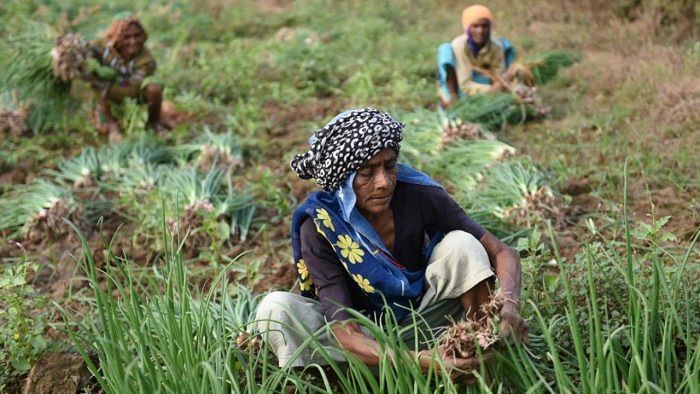
Agriculture forms 20 per cent of our GDP. And a large chunk of this, especially its drylands, is becoming economically unviable. Poverty and vulnerability walk hand-in-hand on these lands, most of which are also degraded.
An article published in Deccan Herald (Nov 19, 2022) highlighted an Isro report that showed a frightening connection between the micro and the macro: 6.96 million ha in Karnataka are currently degraded, making this the fifth largest degraded area in India.
These degraded lands, in turn, are part of the semi-arid. The semi-arid region comprises 37 per cent of the Indian landmass. It stretches from Punjab to Tamil Nadu, encompassing Gujarat. So, it’s a micro-macro-meso framework, and the degradation accounts for a complex of issues that have led to this point.
Also Read | Budget and the rural sector
There are no easy answers. Despite this, a few simple policy decisions have been outlined that have the possibility of changing our mental, developmental, and political landscapes.
Stop land fragmentation. Because of inheritance, land fragmentation is already at an unviable level. The increasingly smaller sizes of land plots cannot make economic sense to those who are most affected by these: the small and marginal farmers.
Increasingly, dry lands in our districts are being held for their realty value, even if these are just boundary pillars, mud roads and drains.
Solar and other projects, where large swathes of ‘cheap’, dry lands are required, offer another realty possibility to hold out for in the future.
Given this, is it possible to stop the fragmentation of our agricultural lands by delinking these from inheritance laws?
Can the land go to the eldest, with others in the family having the right to invest in future crops in a modified practice of pali, or sharecropping, till they are alive and the lands thereafter going to the eldest of each generation? This, if implemented, can be unfair to the younger members and can dilute gender rights, but this has been practiced in Europe earlier, even though that was primarily to protect the aristocracy whose power was mainly based on their lands. Of course, there are Indian answers; we just need to find the best option for ourselves.
Organic now. By now it is clear that the chemicals and synthetics promoted in the name of greater agricultural productivity are leading to dwindling returns, apart from poisoning the food chain. People may not know much about Punjab, but speak of the ‘cancer train’, and everyone nods and shudders.
Also Read | The hidden hunger enemy
a. Establish a mechanism (may be within the district administration) that will allow farmers to apply for and hold a referendum whenever they are ready to go organic at the gram panchayat level.
b. Establish a plug and play mechanism for organic crops that duplicates/replicates the mechanism that made the Green Revolution so successful, and which even today is the only answer the moment a farmer goes in for irrigated farming.
c. The Green Revolution mechanism integrates policy, research, extension, inputs, subsidies, equipment, credit, insurance, storage and markets to form a single, holistic whole.
d. The moment a gram panchayat votes to go organic, this fully functional ‘single window’ (call this ‘Organic Now’, or another name) should become operational at the gram panchayat.
e. Allow the gram panchayat to become the spoke for all agriculture produce:
i. A single point where all local produce is aggregated
ii. Where a farmer can store and sell his produce;
iii. Each GP spoke can then be connected to the hubs that make up a crop ecosystem: a processing mill or equivalent, a bank, etc.
Local production. Help local youth put all the local produce onto the Internet.
a. Brainstorm all the value-adds possible, and the skills required for these.
b. Access government aid to set up local skills and entrepreneur training.
c. Assist the gram panchayat to promote local enterprises.
Local PDS procurement. Allow the PDS to procure and supply local produce. Use a part of the existing subsidy to grow the local economy.
Localise government schemes. Help departments to transfer funds for all agriculture, horticulture, livestock and fisheries production to the gram panchayats. Review what other schemes can be transferred. Allow gram panchayats to retain unspent funds in a gram panchayat development fund. For these departments, fund utilisation will also act as a performance index.
Farm employment guarantee:
a. Convert all dryland crops into sets of standard days of production.
b. Guarantee employment to every farmer up to a cap of 2-5 acres.
c. Allow farmers and their families to register with the gram panchayat to be paid minimum wages based on the crops they are willing to labour for.
d. Land preparation, sowing, weeding, harvesting and transportation should be added to the ‘Shelf of Works’ under the MGNREGA to allow farm labour to be paid for work that they do on these farms.
e. Create similar standard days of production for the many horticulture, husbandry and fisheries produce/products.
f. Explore how this subsidy can be offset by transferring the subsidies for agriculture chemicals, synthetics and others to these organic gram panchayats.
g. Allow farmers to generate significant revenue from the sale of their produce.
h. Savings and investments may be the real pathway to farmers tripling their incomes.
i. Explore over time if an in-out strategy should be developed based on a farm income threshold, or if farmers being paid for a minimum number of acres for the dryland crops they work on should be a permanent safety net that provides a minimum food security.
These six minimum steps, and the others they might spawn, have the potential to focus our attention where it’s needed the most: on our gram panchayats as the new economic hubs to revitalise our agriculture.
(The author is a development practitioner)